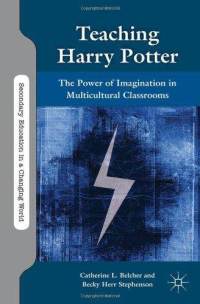September 2012 – Volume 16, Number 2
Teaching Harry Potter: The Power of the Imagination in Multicultural Classrooms |
|||
| Author: | Catherine L. Belcher & Becky Herr Stephenson (2011) |  |
|
| Publisher: | New York: Palgrave Macmillian | ||
| Pages | ISBN-10 | Price | |
|---|---|---|---|
| 216 pages | 0230110282 | $85.00 USD | |
Teaching Harry Potter: The Power of Imagination in Multicultural Classrooms by Catherine L. Belcher and Becky Herr Stephenson looks at why teachers use the Harry Potter series in the classroom, how they have used it, and also how it might be used to address social, cultural and other real world issues. On first glance this seems an odd subject for a book, however, after having read it I can see it as a useful tool for teachers. Its target audience appears to be U.S. based English Language Arts teachers who enjoy the Harry Potter series. It may also appeal more specifically toward teachers who teach ESL students, students from non-dominant communities, or special education students both in and outside the United States.
Teaching Harry Potter: The Power of Imagination in Multicultural Classrooms opens with an introduction that reiterates the popularity of the Harry Potter series and how it is a book series with a positive effect on reluctant readers. It shows how a majority of students and parents say that reading the Harry Potter series led to interest in other books. It also points out that in using a fantasy/science fiction novel is a “safe” way to look critically at modern-day problems and push past curricular constraints that are often limiting.
The text is divided into seven chapters. The odd numbered chapters dig deeper into different aspects of using Harry Potter in the classroom and how it applies to various areas. Throughout the book the authors use Harry Potter references to make real world connections. They speak of “waking sleeping dragons” in terms of addressing issues such as racism, classism, and other stereotypes. They also use the “Defense against the Dark Arts” story line in Harry Potter to address issues in education today. Such as, teachers being forced to teach to the test, instead of being able to do more engaging and creative teaching, e.g., a government agent such as Dolores Umbridge.
The even numbered chapters are about how specific teachers used Harry Potter in their classrooms. Each teacher found a way to use Harry Potter to engage their students and teach them more about reading, the world and themselves. These teachers faced challenges in using these texts, but they pushed against the system in order to find ways to reach their students where they were and in a way that they enjoyed.
A strength of this book is that it uses a popular novel to illustrate how teachers can take something their students enjoy and use it to engage them in contemporary real world issues such as racism, class status, war, morals, and politics. It gives practical connections and ideas that a reader might otherwise not have thought of before and shows how you can use a series of novels to teach these issues in a safe and engaging way.
One weakness is that since it is focused on only one set of novels it is limited in scope. It only addresses ways in which the Harry Potter series can be used, as opposed to incorporating other similar types of fiction. At times is a bit fanatical. It discusses things like the Enlightening 2007 conference (for Harry Potter fans), “Wizard Rock” bands, and the Harry Potter Alliance, which is a volunteer organization that raises money for different causes. While these are harmless and even honorable endeavors, they do not really relate to education. This section sort of crossed the line for me from use in education to propaganda. Overall, however, this is a minor part of the book and was included in the last chapter where they were discussing “imagining more”, so it was given in context. In my opinion, it was not necessary as far as the rest of the book was concerned.
As a fan of the Harry Potter series, I found myself learning new things that I had not thought of before while reading the novels. I discovered new ways to engage my students with interesting novels, ways to address new topics brought up in the books, and many ways to use situations and story lines to teach social issues. Other teachers who enjoy the series may also benefit from reading this book. Non-US language educators may also find this book useful as the Harry Potter series is a worldwide phenomenon and can be used to teach multi-cultural issues. After all, as the book points out, Harry finds himself in a new “country” of sorts and has to adjust to new ideas, customs, and expectations. Educators from all over the world could find useful information in this book and discover new ideas on how to use Harry Potter to teach everyday issues to their students in an engaging and non-traditional way.
Reviewed by
Erin Lynn McNaughton
University of North Carolina Charlotte, USA
<erinmcnaughon![]() ccs.k12.nc.us>
ccs.k12.nc.us>
| © Copyright rests with authors. Please cite TESL-EJ appropriately.Editor’s Note: The HTML version contains no page numbers. Please use the PDF version of this article for citations. |

